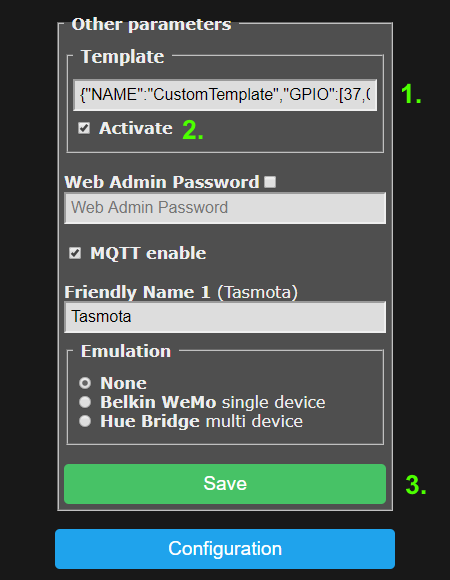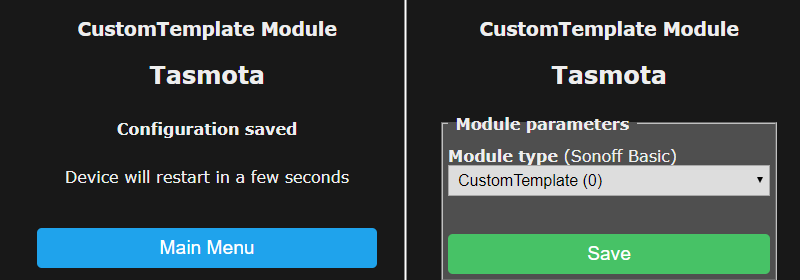Templates
Template is a definition of a device and how its GPIOs are assigned.
Templates provide an easy way for you to create, modify and share configurations for various devices that have features supported in Tasmota.
Bug
Tasmota 9.1 completely redesigned template layout to allow for future expansion. Read more about the GPIO Conversion.
To provide easy processing by Tasmota a template is written as a JSON string and looks like this:
{"NAME":"Example Template","GPIO":[416,0,418,0,417,2720,0,0,2624,32,2656,224,0,0],"FLAG":0,"BASE":45}
Tip
Tasmota Supported Devices Repository has a complete list of supported devices. We encourage everyone who creates a template for a new unknown device to submit it using Add New Template form.
How to Use~
Go to Configuration - Configure Template ...

... and you'll end up looking at this screen.

Time to create your template.
Creating Your Template~
- Change
 the template name (also defines the name for the module).
the template name (also defines the name for the module). - Select a module to BASE your template on. If you're not sure,
Module 18is the best choice. In this example the device is based on Blitzwolf SHP (45) module. -
Configure the components assigned to the GPIOs to match your device. If you do not know what pins your device uses, read about the new device configuration procedure to determine the correct pin assignments.

- Any unused GPIO that has cannot have a peripheral connected should be set to
None(0). In our example the device has no exposed GPIO's so the unused ones are set to0compared to the original BlitzWolf module. - GPIOs that can have peripherals connected to (exposed GPIOs) should be set to
User(1). This allows future configuration through the Configure Module dialog without the need to create a new template.
Example
Sonoff TH has a jack connected to GPIO4 that allows a user to plug in a sensor. Assigning GPIO4 as
Userallows a Template to have correct GPIOs for this device even if nothing is plugged in. But, when a user decides to connect a sensor using the jack, GPIO4 can be set to the type of sensor through the Configure Module page. - Any unused GPIO that has cannot have a peripheral connected should be set to
-
Click on Save and you'll see this message

-
Finally, the device will reboot with the new template name

Exporting Your Template~
Now that you've set up your previously unsupported device in Tasmota it is time to share the knowledge:
- Check that
Module 0is selected in the Configuration - Configure Module menu. - Open up Console and issue command
Templatewhich will output a string with the configuration of your currently active template. Our example gives the following:
MQT: stat/tasmota/RESULT = {"NAME":"Merged","GPIO":[416,0,418,0,417,2720,0,0,2624,32,2656,224,0,0],"FLAG":0,"BASE":45}
Copy the string {"NAME":"Merged","GPIO":[416,0,418,0,417,2720,0,0,2624,32,2656,224,0,0],"FLAG":0,"BASE":45} and share it on the Tasmota Supported Devices Repository.
Importing Templates~
Go to Configuration - Configure Other

When there:
- Paste the template string into the Template field
- Make sure you check Activate
- Click on Save.

The device will reboot with a name reflecting your template name and Module 0 selected which has your new template stored.
If your device was previously configured you will have to manually change to Module 0 in *Configuration -> Configure Module*.

Commands~
A user provided template can be stored in Tasmota using the Template command. It has the following parameters.
| Parameter | Description |
|---|---|
| Show current Template |
0 | Create template from active module |
1..71 | Create template from a supported module |
{ ... } | Store template written in a JSON string |
255 | Merge configured template and current module |
Template {"NAME":"Example Template","GPIO":[416,0,418,0,417,2720,0,0,2624,32,2656,224,0,0],"FLAG":0,"BASE":45} stores a complete template based on the Generic module
Template {"NAME":"AnotherModuleName"} updates the name of a stored template
Template {"FLAG":0} changes FLAG value
Template {"BASE":18} updates the base of a stored template to Generic
Template {"CMND":"LedTable 1"} adds LedTable 1 command to the stored template
After setting a template in command line it is necessary to issue Module 0 command if the device doesn't reboot on its own.
Merge Template with Module~
You can set up your device in module *Configuration -> Configure Module* and use command Template 255 to merge the settings of the Module with current template into a new Template named "Merged".
Anatomy of a Template~
Let's look again at our example template:
{"NAME":"Example Template","GPIO":[416,0,418,0,417,2720,0,0,2624,32,2656,224,0,0],"FLAG":0,"BASE":45}
The four properties with UPPERCASE property names have the following functionality:
| Property name | Property value description |
|---|---|
| NAME | Up to 60 characters for the Module name |
| GPIO | Numbers from 0 to 65535 representing GPIO0 to GPIO5, GPIO09, GPIO10 and GPIO12 to GPIO16 and GPIO17 for A0 pin for ESP8266. ESP32 has more configurable GPIO's |
| FLAG | *Deprecated Replaced with GPIO17. 8 bit mask flag register. |
| BASE | Module number of a hard-coded device to be used when device specific functionality is needed |
| CMND | (Optional) Commands executed after activating the template |
GPIO~
GPIO order~
GPIO# |00| 01|02| 03|04| 05| 09| 10| 12| 13| 14| 15| 16| 17
CODE [416,0,418,0,417,2720,0,0,2624,32,2656,224,0,0]
GPIO functionality~
The GPIO functionality numbers are the same as shown by command GPIOs. In addition code 1 is added to select a GPIO as user configurable via the GUI Configure Module menu.
Example
In our example the GPIO 12 data element is 32 which corresponds to the Button1 component, according to the components table. If you change that template element to 160 it would then be assigned as a Switch1 component instead.
Components~
See Components for a complete list or use command Gpios 255 in console.
FLAG~
Before Tasmota 9.1 used to configure the ADC type. In new templates this should be set to 0 and the analog pin should be configured on GPIO17
| FLAG | Feature description |
|---|---|
| 0 | No features |
| 1 | Analog value |
| 2 | Temperature |
| 3 | Light |
| 4 | Button |
| 5 | Buttoni |
| 15 | User configured (same as User) |
BASE~
BASE is the starting module setup for the custom template. Some modules include special programming. If your device is similar to an existing built-in module it is best to use that as a starting point. When you're not sure which BASE module is suitable for your device use the Generic (18) module. A list of hard-coded devices can be found in Modules.
Example
In the RGB Smart Plug template we used the BlitzWolf SHP (45) module as BASE since the power monitoring circuitry is identical but GPIO00 and GPIO02 were changed and an unused GPIO04 was added to enable the RGB LED function. Using that specific module we took advantage of that module's calibrated power monitoring special programming which the Generic (18) module does not use.
CMND~
CMND is an optional field in the template JSON string. It is used to embed commands for configuring the device instead of needing to type them in console. Multiple commands are separated with |.
"CMND":"<any template related command>|<any template related command>|..."
Commands will only be executed if the template is enabled (device module is set to 0), either before the template is loaded, when the activate box in the UI is selected or if the module 0 command is included in the CMND string itself.
Disable LED gamma correction and remap RGB channels
{"NAME":"Example","GPIO":[416,0,418,0,417,2720,0,0,2624,32,2656,224,0,0],"FLAG":0,"BASE":45,"CMND":"LedTable 1|ChannelRemap 36"}
Total size of the template string should not exceed 500 chars.